Highly Recommended Award
Our Highly Recommended designation is earned by products offering extraordinary value or performance in their price class.
- Solid-state laser light engine
- Google TV OS with Chromecast, Google Assistant, and working Netflix
- Excellent placement flexibility with swiveling/tilting stand
- Good on-board sound system
- No game picture mode or low-input lag mode for gaming
The 1,000-lumen Epson EpiqVision Mini EF22’s compact, unique swivel design, auto-setup features, and integrated Google TV make it ideal for environments where space is limited. The projector’s vibrant image and spacious audio are sure to impress families, students, and cinephiles on a budget.
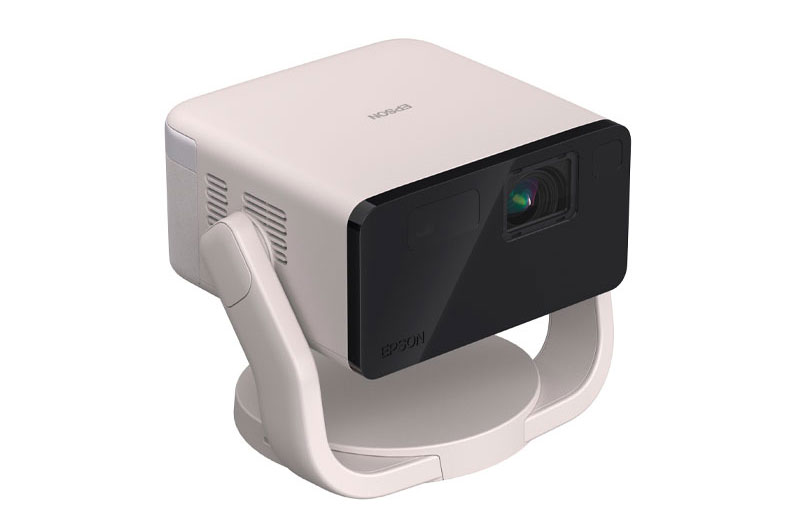
The Epson EpiqVision Mini EF22 is a portable, smart, 3LCD laser projector with 1,000 ISO21118 lumens. It is an update to Epson's earlier EF12 portable projector that adds some attractive features. It comes in multiple colors to match your décor and has a swivel stand and auto features that make setup a breeze. The EF22 comes preloaded with dozens of popular streaming apps and is ready to watch live news—as well as Netflix— thanks to the latest Google TV OS. The projector has 5-watt stereo speakers with Dolby Audio and eARC for connecting an external sound system. It can project up to 150 inches at 1080p resolution with HDR and supports 4K content. The EF22 has Chromecast and works with Android, iOS, Windows, and Mac devices, but doesn't have AirPlay. Epson's warranty is also one of the better ones around, a 2-year limited with full-unit replacement. For an additional $85.95, you can get a 1-year Extended Service Plan that covers replacement and repair.
While the EF22 presents a compelling story, it faces some solid competition in its class. The Anker Nebula Mars 3 is a DLP projector that retails for $900 while offering the same 1080p resolution and a max screen size of 200 inches. It has a similar 1,000 ANSI lumen claim and measured 959 lumens in our review. It also has a powerful 40-watt Dolby Audio sound system that, based on my testing, is of the best I've ever heard on a home entertainment projector, especially at this price range, and is far superior to the Epson's. While its Android OS lacks an approved Netflix app like the Epson's, the projector is built to travel outdoors with a 5-hour built-in battery, a camping light, IPX3 water resistance, 0.5-meter drop resistance, and 0.7 mm dust resistance. The Mars 3 remains one of my top recommendations when someone asks me for a $1000 projector recommendation. An another recently reviewed Anker alternative, the Nebula Cosmos 4K SE, carries a $1,299 list price but has recently been found promoted at $1,000. It boasts 4K resolution, considerably higher brightness at 1,800 verified ISO lumens, and the Google TV OS with working Netflix app, but it comes without the Mars 3's outdoor/camping cred.
There's also the Dangbei Atom for $900, another 1080p DLP mini projector, which claims 1,200 ISO lumens and comes with a Google TV OS that has Netflix. It's ultra-thin and lighter than a laptop, making it highly portable. It also features fast auto focus and keystone, intelligent screen fit and obstacle avoidance, and support for 3D content. We have not tested it to verify its brightness claim or listen to its sound system, but by virtue of the projector's small size and 2x 5-watt speaker rating, it's not likely to compete well against the Epson's or especially the Anker's on-board audio.
Features
Right off the bat, the Epson EpiqVision Mini EF22 impresses with its industrial design. It's offered not just in the usual black and white options, but with five total color options to choose from, ensuring your projector matches your décor: Quartz Rose, Onyx Black, Opal Green, Diamond White, and Stone Blue. The test model Epson sent was the Quartz Rose, which has a matte, dusty rose color on the main body and stand of the projector, and a rose gold look to the inputs and connectors panel, which is a thin strip along the top back of the projector above the soft pink mesh of the speaker. The front of the projector features a shiny black covering, housing the projector's lens. It's a highly attractive projector, and if you choose one of the colored models, absolutely a conversation piece.
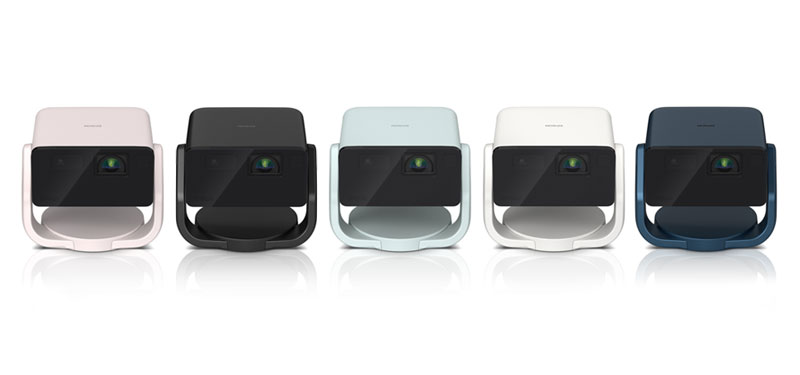
This smart projector is portable at 9.3-inches x 7.5-inches x 7.5-inches and 6.6 lbs. Though lightweight, the projector is sturdy and well-made. It comes equipped with a swivel stand, allowing you to pan 360 degrees and tilt 150 degrees to project a picture of up to 150-inches wherever you please. The projector has a fixed lens with a 1.03:1 throw ratio, so maximum image size is determined by proximity to your wall or screen. It will do a 100-inch image at 7 feet, 4 inches from the projection surface. Use our Epson EF22 Throw Distance Calculator to check out the throw distance for your desired max image size.
The projector features Epson's EpiqSense technology for real-time sensor analysis to automatically downsize, align, keystone correct, and focus the picture for optimum performance. It also has automatic obstacle avoidance that will resize the image if the projector sees a wall outlet or hanging picture frame in the projection area. You can also manually adjust all of this yourself, but the automatic features are there for you if you want them.
Something to keep in mind when placing the projector: under certain conditions the Epson EF22 displayed occasional moiré—a subtle distortion of rainbow-like patterns—primarily on large blocks of solid color. This was likely due to the interaction between the pixel grid of the projector and the texture of my particular projection screen. When I moved the screen further back, the effect disappeared, suggesting that placement is important, as is your choice of projection surface. Projecting onto a smooth wall eliminated the issue, as did projecting onto my larger 100-inch screen vs. the 60-inch screen I started with. Digital adjustments like keystone correction and zoom can also exaggerate the moiré effect, and it was more noticeable in brighter picture modes like Dynamic or Vivid.
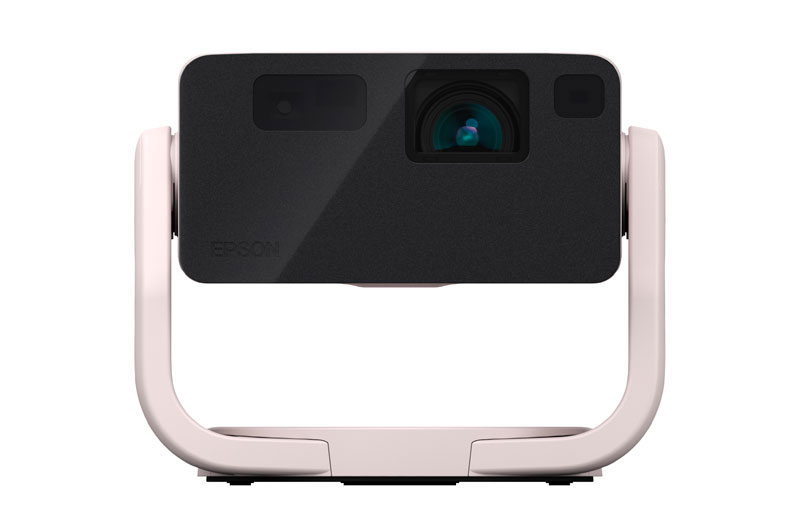
The laser light engine lasts up to 20,000 hours, and the projector has 3LCD technology, which means it produces as many color lumens as it does white lumens. This translates to a brighter, more vivid looking picture, even in the face of ambient light. Speaking of lumens, the EF22 claims 1,000 ISO21118 lumens in its brightest mode, which it exceeded in our tests, hitting 1,081 lumens. The EF22 has 1920x1080 resolution from its three 0.62-inch LCD chips, but it handles 4K signals with HDR and has four preset color modes and one custom so you can get the color exactly how you like it.
It has Google TV built-in, giving you access to your favorite streaming apps like Prime Video, Disney+, YouTube TV, and over 10,000 others. Notably, this includes a certified Netflix app, which was missing from most earlier Android TV operating systems. Setup is easy. First, you turn on the projector and pair the remote by pressing the Home and Back buttons on the remote for three seconds. Then, you choose the language you will be using on the projector, followed by your region. For me, this was English and United States. From there, you can choose to set up either Google TV or basic TV. I chose Google TV. For this, you just have to download and open the Google Home app on your phone or tablet and scan the QR code on the projection screen.
When you open the Google Home app, go to the Devices tab and tap + Add in the bottom right-hand corner. A screen will pop up. Tap that and hit Next in the lower right-hand corner when prompted. It will search for your Google TV and ask if you want to set it up. Hit Next. That will bring up the screen to scan the QR code. Then you just tap Accept, Agree to the legal terms, and choose the location of the device (Bedroom, Living Room, Basement, etc.), before naming it and finally connecting to your Wi-Fi network.
This concludes setup within the app, and the rest takes place on the projector itself. There's a short wait to allow the setup to complete and you'll get to see the progress bar's percentage creep up to 100%. Make sure you set up the projector well ahead of the time you're expecting to entertain, because it will take at least 20 minutes to a half hour or so to complete setup. Signing into streaming apps like Prime Video and Netflix is easy as well. Thank goodness for those QR codes. It makes the whole process quick so you can get to the good stuff immediately. Within Google TV, Netflix, Prime Video, Disney+, Google TV FreePlay, Hulu, Tubi, YouTube, YouTube TV, YouTube Music, Live TV, IMPlayer, Twitch, Apple TV, STARZ, Epson Projector Update, Spotify, and Max, are all under the Your Apps section of the Home screen. There is an option to reorder or add apps as well from Google's app store. Under that are tons of free live news and opinion options, top selling movies, popular movies and TV shows, recommended videos and more.
You can use Chromecast to screen mirror from your phone, tablet, or computer. To cast, you can use the Google Home app on a mobile device or use Chrome on a computer. Via Chrome, just go to the View tab at the top of the screen and click on Cast. The EF22 will show up and you can cast the current tab you have open. There's a Chromecast app from Google that has Pro features you don't need to pay for, which allows you to broadcast from your phone via the Mirror tab of the app. This works well. It doesn't route the audio to the projector, though. For that, you have to upgrade to Pro. That's how they get you. Apple has its own Chromecast app that you also have to pay for, but most of what you'll want to watch on the EF22 is accessible directly from the Google TV platform, even a built-in internet search app, so you've really got everything you need within the projector.
The inputs and connectors panel is simple—just a few ports along the rose gold strip of metal that spans the back of the projector over the speakers. The power cable plugs into the swivel base on the right when facing the projector's lens. From left to right, you have the On/Off button, a USB Type-B port, a headphone jack, a USB Type-A port, and an HDMI input with eARC for connecting an external sound system.
The projector itself has two built-in 5-watt stereo speakers with Dolby Audio. There are four audio modes: Standard, Vocal, Music, and Movie. Movie is obviously the best mode for watching movies. It also has Bluetooth Speaker Mode to turn the projector into a speaker to play music on. It also works for audiobooks, or any other type of audio you might want to enjoy. For that, using either Music, Vocal, or Standard audio modes will be your best bet. More on how these modes sound in the Performance section of this review.
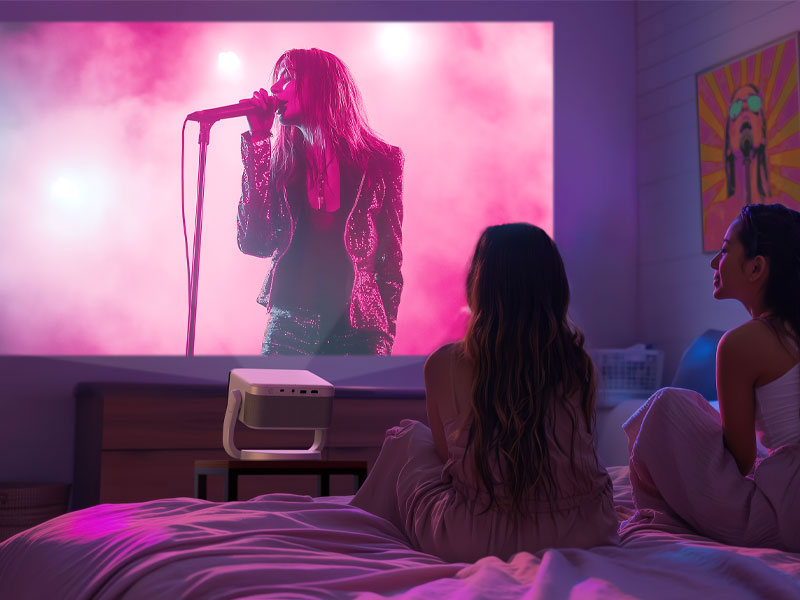
The remote control is lightweight, black, and does not have a backlight. The top configuration consists of five buttons. The Power and User Profile buttons are stacked on the left, the Inputs and Settings buttons are stacked on the right, and the Google Assistant button is centered between them. A nondescript white navigational ring circles the black Enter button and can be used just like any navigational arrows.
Below that are three buttons: Back, Home, and a button to quickly switch to the HDMI source. The next grouping of buttons is the +/- Brightness buttons on the left and +/- Volume buttons on the right, with the automatic focus button in between. The bottom four buttons are for YouTube, Netflix, Prime Video, and the projector menu button. You can point the remote control at the screen and still control the projector—it doesn't have to be directed only at the projector, which is nice.

What's in the box: The projector, a remote with two batteries, the power cable and its power brick, and a thorough Quick Start Manual in multiple languages. The EF22 manual can be viewed and downloaded from ProjectorCentral's Epson EF22 database info page.
Performance
Color Modes. The Epson EpiqVision Mini EF22 has five color modes: Dynamic, Vivid, Natural, Cinema, and Custom. All of the modes have decent to excellent color, and there are a couple that can handle ambient light. The projector accepts a 4K HDR signal and outputs it as 1080p HDR. When I initially connected my Sony UBP-X700 UHD Blu-ray player and played a 4K HDR disc, the player defaulted to sending a 1080p SDR signal. However, when I used the player menu to force 4K output, it accepted the signal for display at the projector's native 1080p and triggered an on-screen HDR indicator. To confirm that the projector is outputting an HDR signal, press the setting button on the remote control twice and the projector information will appear at the edge of the screen. There is no additional menu page for signal information as found on some projectors (resolution, dynamic range, etc.), and there are no HDR luminance or tone map image adjustments available.
Dynamic is the best mode for optimizing brightness and measured 1,081 lumens, which is over the 1,000 lumen claim. It is very vibrant and does a decent job of reproducing color for the brightest mode, as these brightest modes tend to be quite green. In this case, the yellows are the most vivid, and the greens on the color wheel range from a lime green to a sort of muddy green, and the oranges are a bit muddy as well. The rest of the colors looked good, though, including reds, magenta, violet, and all shades of blue.
When it comes to skin tones, Dynamic did alright. It does have that green tint to it, but it's totally bearable. If you must use this mode to watch TV, movies, or play games during the day, you can do so without sacrificing too much in the way of color. You can adjust the Color Temperature to either Warm or Cool—it's set to Standard by default—and Warm fixes that green issue immediately. It can actually be quite nice when set to Warm, and I'd use this mode to watch content during the day if my room was super bright with mostly no complaints.
Vivid is the best mode for projecting general content in a bright environment. It measured 755 lumens. In Vivid mode all the colors looked excellent. Quite vibrant, but every color looked as it should on the color wheel. On some content it may be too vivid, but for daytime viewing, it was quite excellent. The tone was cool.
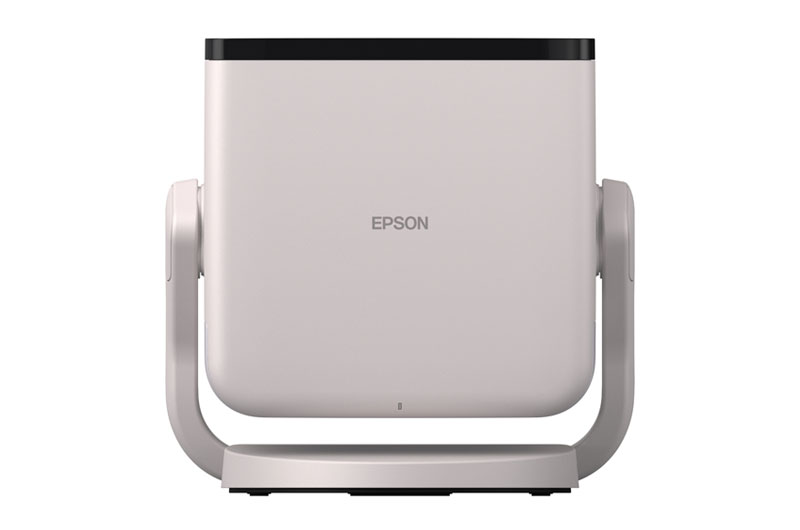
Vivid had the same issue as Dynamic when projecting skin tones in that the color was a bit off—a little green or blue tinged in some cases—and it also benefitted from changing the Color Temperature setting to Warm. On some content, like animated films such as Big Hero 6, you may not want to do this, so it will likely be a case-by-case basis. It's an easy enough switch.
Natural, which measured 699 lumens, was the best mode for projecting the image as-is. Its tone was much warmer than Vivid's. All the reds and oranges were quite distinguishable from each other, too, which was excellent. Sometimes these warmer modes can lose that definition. This mode was the most true-to-color of the lot when it came to the color wheel, but it wasn't the best mode for content. It reproduced skin tones of all types nicely, with no need to fuss with the Color Temperature setting, though the contrast left something to be desired.
Cinema was the best mode for projecting movies and cinematic TV shows in a dark environment. Cinema actually had a cooler tone than Natural, which is traditionally the most color accurate mode on Epson home theater projectors. Due to its cooler tone, Cinema appeared brighter than Natural mode even though the two modes have the same lumen measurement. The colors of this mode were nicely vibrant, but the red and red-orange were a little closer to each other than they were in Natural mode. Still, excellent. It also reproduced skin tones beautifully. If you wanted to, you could apply that Warm Color Temperature setting to it, but it's not necessary.
Custom had the same color as Natural mode, so that's what you start out with. You can tweak the color from there using the available image adjustments. From the main Picture menu, you can adjust Color Temperature and Brightness. Once you select the Custom picture mode, it brings up Contrast, Saturation, Sharpness, Color Gain, and Gamma. This mode measured 670 lumens.
1080p Viewing. I watched A Ballad of Songbirds and Snakes via Google TV and Prime Video. The best mode for doing so was definitely Cinema. The colors were excellent. Skin tones looked natural and so did hair. The highlights and shadows looked right. In other modes, the contrast could be a bit too much. The black level performance in this mode was good. Dynamic was usable, but only if the Warm Color Temperature setting was selected. The highlights were pushed, but not too much. It was definitely watchable, especially if your room is bright. I didn't really like Natural mode for the film, even switching the Color Temperature to Warm or Cool.
During the day in ambient light, Outer Banks, Season 4 was watchable in Dynamic mode, but it had to be changed to Warm Color Temperature. The highlights are definitely pushed in this mode, but if you really need the extra lumens, it's not bad. It's already a warm-colored show, so when watching it in Vivid, the Standard Color Temperature setting worked fine. It looked much better than Dynamic, though.
You could watch it in Cinema mode, but the blacks will be washed out when there's ambient light present. The shades were drawn at the time, a couple hours before sunset, so light was still peeking in between the blinds, and I had a window open in the hall with light streaming into the room from there. Not optimum conditions for Cinema mode, but it was okay.
I was trying to find an animated film I might be familiar with on Netflix, but it had been a while. I came across Invader Zim: Enter the Florpus. I watched Invader Zim all the time when I was a kid, back in the 90s and early 00s. I still had Cinema mode on, and that's fine on animated content during the day. Vivid yields a more pleasant viewing experience, though, because it brings out those vibrant colors that are present in these cartoons.
Big Hero 6 in 1080p was highly enjoyable. While Vivid brought out all those beautiful colors, particularly the reds, the highlights were overexposed, and I felt the film looked much better and more natural in Cinema mode. The colors were richer, and the blacks were darker. The dark shadow detail was also good.
1080p HDR Viewing. Since I ended my 1080p viewing session with Big Hero 6, I started off my HDR viewing session with it. Forced 4K HDR content from my UHD Blu-ray player, as expected, looks gorgeous even when it's scaled down to the projector's native 1080p resolution. It's sharp and has great color in multiple modes. Vivid mode actually looked fantastic when projecting this film. Those colors were deep, rich, vibrant, and the black levels were excellent. Dark shadow detail was good, too. The highlights weren't too much, either. Cinema mode also looks great on this title, but Vivid is where it's at for this film. I'm thinking it's what will be preferred for 4K animated films.
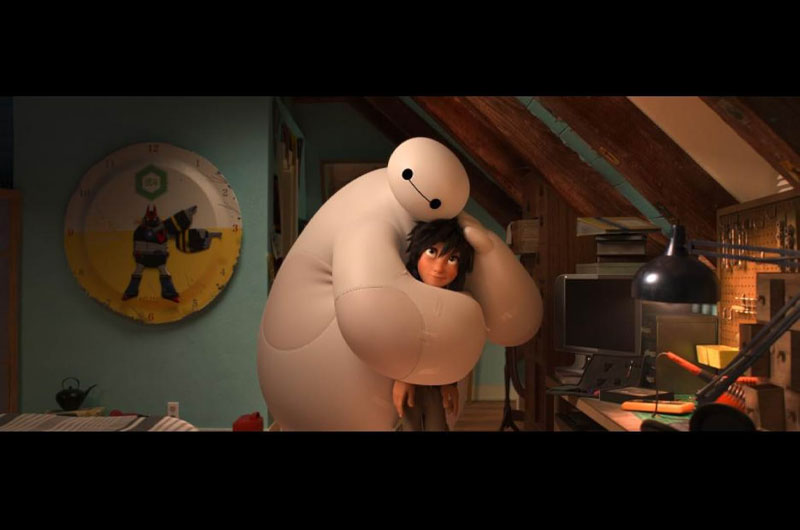
The Meg has many dark, deep-water scenes that look great in Cinema mode. By the time my movie testing sessions rolled around night had fallen on the West Coast (yay daylight savings—it's good for something), so I could really see the black level performance in this mode. It's rather good for a $999 home entertainment projector. Epson generally does a good job with this. The dark shadow detail was also good on this film when projected in Cinema mode. I checked out Natural mode and it was just too flat. Vivid was too vibrant. It would probably be okay during day when your main concern is seeing the movie over color and black levels.
Top Gun: Maverick had some rich, beautiful color. I got pretty sucked into that film when testing. I liked the original when I was a kid, especially the soundtrack, which we had on CD and blasted all the time on the stereo. The skin tones really stood out to me while watching the sequel, as did the textures of the uniforms. It looked decent in Vivid mode, but Cinema made the skin tones look even more natural, as would be expected. In general, it made the film look pretty gorgeous.
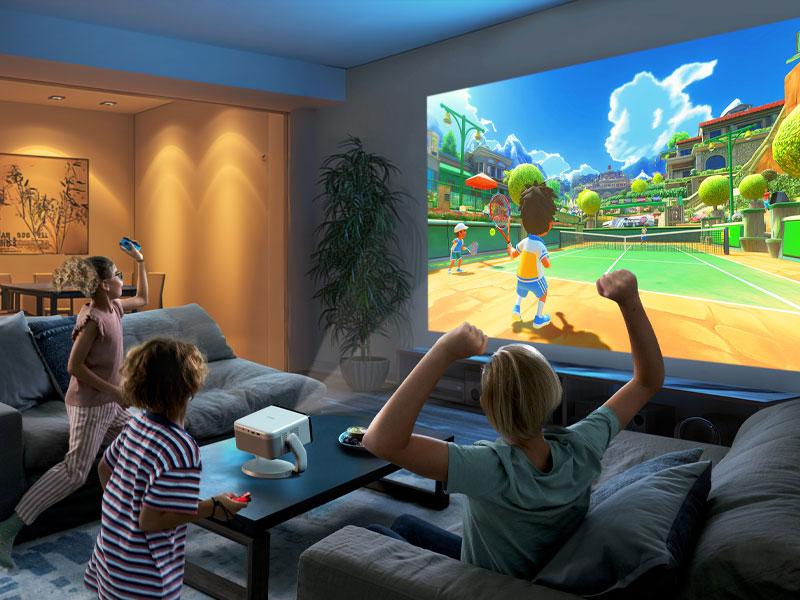
Gaming. Epson doesn't promote the EF22 as a gaming projector. It has no dedicated game picture mode, and input lag measured at about 61 milliseconds for either 1080p/60 Hz or 4K/60 Hz signals coming in from a Bodnar lag meter. This is suitable only for casual gaming.
Ghost of Tsushima can be a challenging game for some projectors to work with when it comes to color. The difference from daytime to nighttime is significant, and color modes often struggle to compensate unless there is a dedicated game picture mode, which this projector doesn't have. Even then, the results can be inconsistent.
The closest option for the EF22 is Vivid mode, which was passable. It wasn't as good as projectors that do have a proper game mode, as those tend to have a cooler color temperature and provide better dark shadow detail. However, since there's no other real option, Vivid will do. While Cinema looked visually better in terms of color and black levels, it would be tough to play the game when nighttime hits within the game and the content gets darker. Playing the game in ambient light is not ideal, even in Vivid mode or Dynamic mode.
Hopping into Hogwarts Legacy, I found the EF22 to be disappointing. I went into the Forbidden Forest for its dark and shadowy atmosphere—a good test of a projector's abilities. I could barely see where I was going most of the time. Only Dynamic mode really worked, and even then, manually adjusting the brightness of the laser somewhere between Standard and Eco was just passable. But I wouldn't want to fight enemies like this. The brighter part of the games look great, and Vivid or Cinema work well for those. The problem lies in those dark spots.
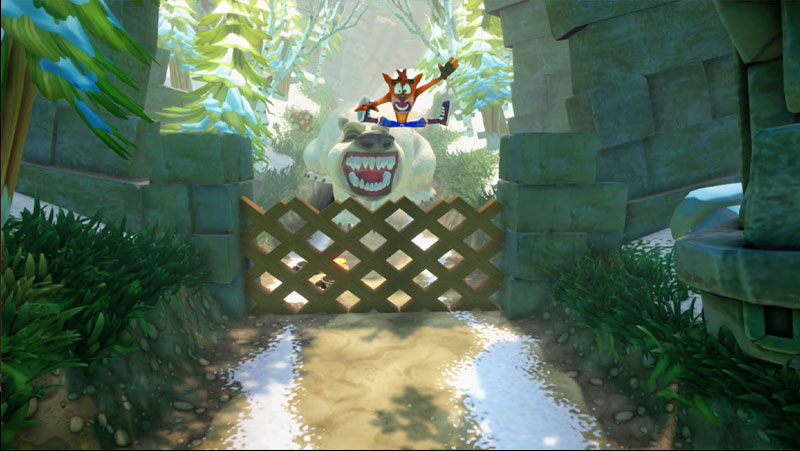
The best games for this projector are brightly colored games. Many Nintendo Switch games would be appropriate—any Mario Bros game, for instance. To test my theory, I popped in my Crash Bandicoot N. Sane Trilogy disc. Dynamic mode was a hard pass. It looked awful. You can play the game just fine in Vivid with the lights on, especially if you set the Color Temperature to Warm. It's still not a good look, but better than Dynamic. With the lights off, you can use Cinema, and that looks rather nice.
Gameplay-wise, the projector performs well despite the relatively high input lag. I didn't encounter any issues while playing Ghost of Tsushima, Hogwarts Legacy, or Crash Bandicoot N. Sane Trilogy, though none of these present the same challenges as a first-person shooter. My main concern is with the color modes for single-player RPG games, and first-person shooter games, as they would have the same problems. However, typical brightly colored, family-friendly games work just fine on this projector.
Want more articles like this?
Subscribe to get ProjectorCentral's comprehensive coverage of projector tech delivered directly to your inbox.
Audio Quality. The Epson EF22 features two built-in 5-watt stereo speakers with Dolby Audio and four audio modes: Standard, Vocal, Music, and Movie. An external stereo system can be connected via the HDMI with eARC or Bluetooth, and headphones can be connected via the 3.5 mm jack. The projector can also be used as a Bluetooth speaker via Bluetooth mode.
The speakers really shine at full volume. For some, that'll be a bit too loud, but for movie night—you may just feel like you're in the movie theater. The intensity of Dr. Gaul and Dean Highbottom's voices when they spoke to the mentors at the beginning of The Hunger Games: The Ballad of Songbirds and Snakes, the chilling timbre of Lucy Gray Baird's song in response to getting chosen at the Reaping, were captured beautifully by the Epson's onboard speakers.
The soundtrack of Top Gun: Maverick was highly enjoyable, as was the sound design of the film. I always like to listen to the jets take off to see how each projectors' onboard speakers handle that kind of deep, rumbling bass, and the high whine of the engines. It's got such intricacies to it that can get lost if the speakers aren't so great. The Epson EF22's speakers did not disappoint, especially when Pete Mitchell reaches Mach 10 at the beginning of the film.
Music mode captures the full spectrum of sound, from bass to treble, and it is a highly enjoyable experience to listen to music on the Epson EF22. The speakers are powerful and have none of that tinny quality onboard speakers can have. I listened to some music from Kingdom Hearts, "Beethoven's Five Secrets" by The Piano Guys, and "Moonlight Sonata First Movement" performed by Lola and Hauser. Chills on that last one. Then, that sent me down a Hauser rabbit hole, and I listened to his performance of "Now We Are Free" from Gladiator, and "He's a Pirate" from one of his concerts. He's a phenomenal cellist and I really enjoyed listening to music on this projector.
After spending a considerable amount of my day listening to classical music and film and video game scores, I had to yank myself away to test some alternative rock and pop music. First up was "Wildfire" by Black Pistol Fire, because it's one of my favorites and we just had some wildfires in California, so I've got fire on the brain. You could switch it to Vocal, but I didn't like it. It does boost the vocals, which might be good on a Zoom call or for watching news, but compresses the music something awful. While we're on the subject of being wild, "Wild Child" by The Black Keys was up next. I selected their music video, which is hilarious and totally inappropriate for a large portion of the population. Make that... most of the population. In any case, the music sounded excellent in Music mode.
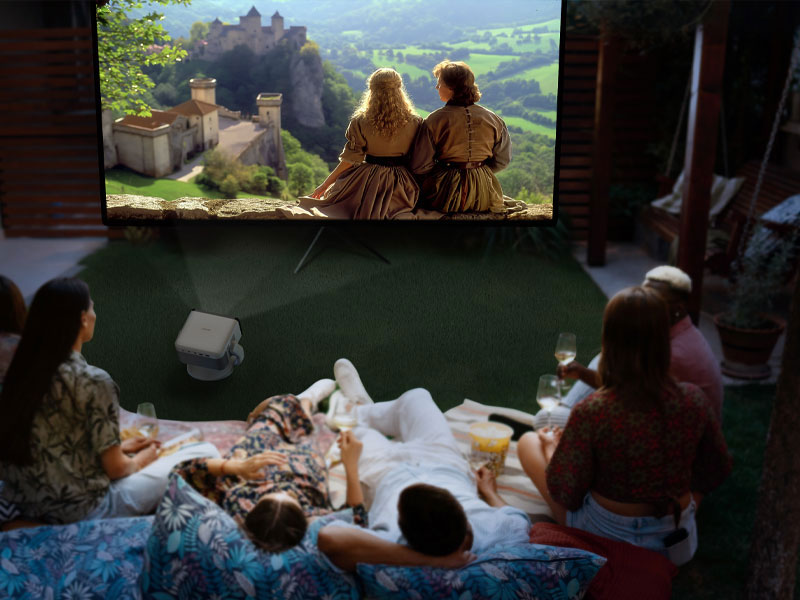
After that extravaganza I felt like I needed a palate cleanse, so I threw on "Lost Stars" performed by Adam Levine from the film Begin Again. Then, we're right back into the realm of the depraved with "Bad Guy" by Billie Eilish. Oh well. What can I say? It has a fantastic bassline. Duh. Sounds great on these speakers. Honestly, I think Movie and Music modes are the two audio modes you'll spend the most time in.
Even for audiobooks. I started listening to Fourth Wing by Rebecca Yarros—one of my favorite books (love me a dragon war college)—in Vocal audio mode. Too much. Too loud. Too yikes. Standard was flat. Cinema is good. It's just so well-rounded. Music mode also works for audiobooks. There are these types of audiobooks called Graphic Audiobooks, which have a full cast of actors, sound design, and music. They're awesome. These would be fantastic in both Cinema and Music modes.
Conclusion
The Epson EpiqVision Mini EF22 is a capable compact projector that blends strong smart features with some limitations, making it an excellent choice for specific audiences but not necessarily for everyone. Its 1080p resolution and support for HDR content deliver impressive image quality, with bright and vibrant colors that excel in darker viewing environments. The projector's unique, sleek design and built-in 5-watt speakers with Dolby Audio further enhance its appeal, providing decent audio quality without the need for additional sound equipment—but audiophiles are appeased with that eARC connection so they can connect their external sound system.
The EF22 slightly exceeds Epson's brightness claim in Dynamic mode, though Vivid mode will likely be the sweet spot for most users for daytime viewing, balancing brightness and color accuracy. For live action film viewing at night, Cinema mode will be the top choice, though Vivid will likely be preferred for animated films to keep those vibrant colors looking as they should.
This projector isn't ideal for most gamers. Putting aside the fact that the input lag is higher than most would prefer, none of the color modes work well with games that have darker atmospheres, which are bountiful in single-player RPGs and many first-person shooters. Families who play games on Nintendo Switch, or games like Crash Bandicoot N. Sane Trilogy on PlayStation, wouldn't have any issues with the color modes on such games.
The Epson EF22 is best suited for those seeking a versatile projector with excellent placement flexibility and solid overall performance. It offers great value for those who prioritize ease of use, portability, and strong image quality for film and TV content over ultra-low latency or professional-grade features. While it may not be perfect for all scenarios, its compact form factor, thoughtful design, and dependable performance make it a strong contender in the mid-range projector market.
Measurements
Brightness. Epson claims 1,000 lumens for the EpiqVision Mini EF22 projector in Dynamic mode, and it beat its claim at 1081 lumens based on the 9-point averaged measurement technique outlined in the current ISO21118 standard. Every Epson projector I've ever reviewed in my career has beat its claim, so I'm not surprised. While Dynamic wouldn't be the mode I would choose for my TV and movie viewing, nor for gaming, with this projector it will do in a pinch.
With Vivid being 755 and looking much brighter than that, you can use it to watch content in a moderately bright environment. In broad daylight with my shades drawn, the living room is still quite bright. Too bright to do any lumens measurements or any testing that has to do with color, unless I'm considering the projector's performance in ambient light. That being said, Vivid mode was perfectly fine for watching The Hunger Games: A Ballad of Songbirds and Snakes and checking out regular video content during the day.
Epson EpiqVision Mini EF22 Lumens
| Mode | Normal | Eco |
|---|---|---|
| Dynamic | 1,081 | 755 |
| Vivid | 755 | 491 |
| Natural | 699 | 444 |
| Cinema | 699 | 415 |
| Custom | 670 | 425 |
Brightness Uniformity. The Epson's brightness uniformity is 76%, which is decent. The left three sectors of the screen measured lower than the six to its right, with the center and top center sectors being the brightest. The brightest sector of the screen measured 1,209 lumens, while the dimmest measured 925 lumens. Still, the difference in brightness across the screen wasn't visually obvious. There is a bit of laser speckle, but it's not awful or distracting.
As mentioned, the Epson EF22 occasionally displayed a bit of subtle moiré effect, primarily visible on large blocks of solid color when the projector was set at certain throw distances and likely due to the interaction between the pixel grid of the projector and the texture of my projection screen. When I moved the screen further back, or projected onto a smooth, light-colored wall, the effect disappeared, suggesting that placement is important, as is your choice of projection surface. Where it did appear, the artifact was more noticeable in brighter picture modes like Dynamic or Vivid, but was far less evident in darker scenes, such as those in The Hunger Games: A Ballad of Songbirds and Snakes, than it was in Big Hero 6, which had larger blocks of solid color. Viewer's may never notice this if their setup conditions don't warrant it or the content doesn't reveal it, but if it does appear, it should be easily corrected.
Fan Noise. While Epson rates the EF22's audible noise at 18-22 dB, I measured it at 32.3 dB in Normal mode and 31.1 dB in Eco mode in a casual measurement taken 5 feet in front of the projector. Despite this, the fan is subjectively very quiet and unlikely to distract most users, if the sound is even picked up at all.
Input Lag. Epson doesn't promote the Epson EF22 as a gaming projector and doesn't have any specified claim for latency on the website, nor in any of their literature. When measuring the EF22's input lag in 1080p at 60 frames per second, the latency was 60.7 ms. In 4K at 60 frames per second, it was 61.9 ms. That's about one second behind on a 60 fps game, two seconds behind on a 30 fps game. While it may not be a big deal for most casual gamers—such as families playing Nintendo Switch games or kids playing games like Roblox, Minecraft, or Mario Kart— other gamers might find it to be an issue, particularly for online gaming. For context, the best gaming projectors suitable for highly competitive play have lag around 16 ms or less.
Connections

- HDMI/eARC
- USB Type-A
- Aux analog stereo out: 3.5 mm jack
- USB Type-B
- Power Supply: AC In
For more detailed specifications and connections, check out our Epson Epiqvision Mini EF-22 projector page.
To buy this projector, use Where to Buy online, or get a price quote by email direct from Projector Central authorized dealers using our E-Z Quote tool.
The Epson Epiqvision Mini EF-22 is also sold outside of the United States of America as the Epson EF-22N. Some specifications may be slightly different. Check with Epson for complete specifications.







